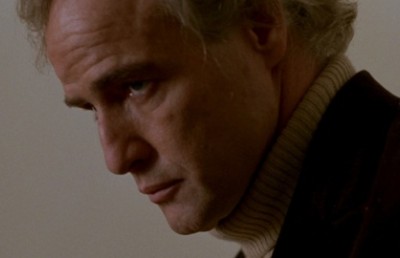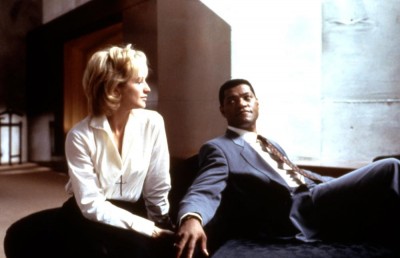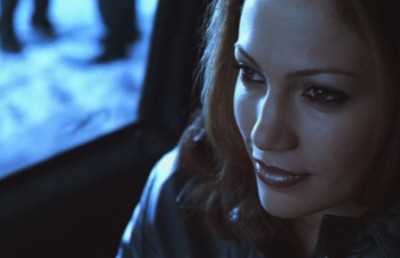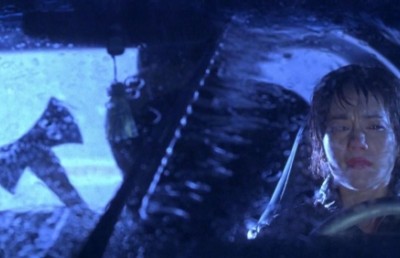Shirley Knight and the Performance of Gendered Race in Dutchman
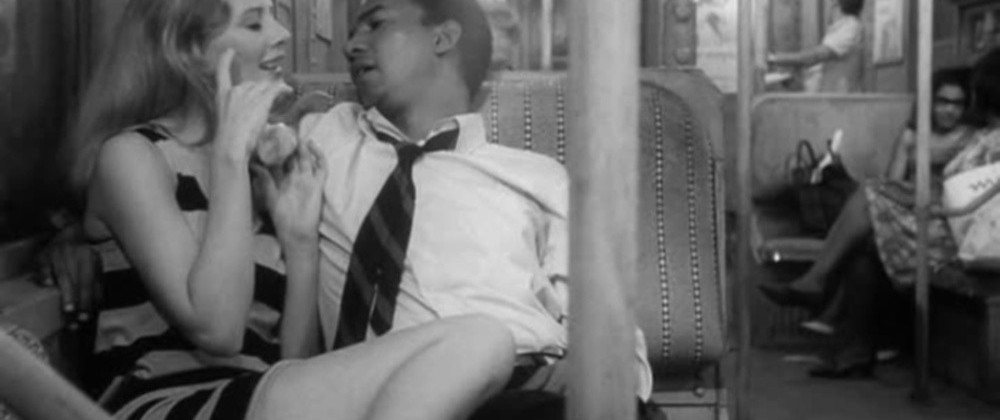
Framed in a long-shot a blond woman stands alone down along an underground subway platform, she is leaning against the wall. The woman wears sunglasses, a striped mini-dress and holds a large purse, by the strap, in her hand. The bag will later be revealed to be full of apples. A train approaches. The camera cuts to an interior medium-shot of a young black man in a suit reading a newspaper. The man turns his head, right, and sees the woman on the platform. He looks at her. The woman turns and sees the man looking at her. At once she, the object of his gaze, returns the gaze. She turns her head and smiles crookedly at him. She meets and holds his eye. The camera cuts to a medium-shot from the outside of the train looking in at the man who looks down and away, shaking his head as though he were clearing a thought from his mind. His brow furrows momentarily and then he pulls his chin in, towards his chest. The man displays a subtle gesture of evaluation. First he considers, he seems to acknowledge the feasibility of an idea, and then he shakes it off. The camera cuts back to a medium-shot from the inside of the train looking out at the woman on the platform. She turns her body, left, so that she is squarely facing the train, the window, the man, and the camera. She leans slightly on her left leg, her head tilts back and to the right. She is actively looking. She provocatively licks her upper-teeth and lip with the point of her tongue.
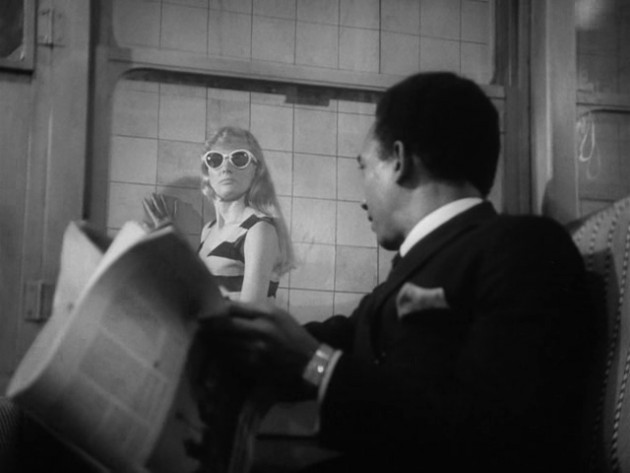
The camera cuts to a medium-close shot through the window looking in at the man who cautiously looks, right, out the corner of the eye. He appears nervous. The woman now actively possesses the gaze while he, the object of the gaze, looks away down and left in shame and then back up meeting her eye. Train sounds signal that the train is about to leave the station and as the man turns his head away from the window the camera cuts to a low-angle medium-close shot inside the train, through a railing, up at the man. As he turns his head center his lip curls up to the right, displaying a hint of disgust. His eyes come up, stopping short of the horizon, looking past his newspaper at nothing in particular. The man is lost in thought; no doubt he is replaying the strange exchange in his mind. He raises the newspaper in front of his face and tentatively casts a look down and out the window, but not up to meet the woman’s eye, and then he quickly looks back down inside the train. Straightening the newspaper in order to read, his face softens and his eyes are distant. He does not sigh though he does pause, giving the impression that he is considering this odd exchange. His mouth closes gently and his face pulls down into a frown. His upper-lip curls into a sneer of contempt and his eyes return to the paper as his gently shrugs. As the train pulls away from the station the man appears to let go of this odd exchange. With his eyes and face, the man expresses that he is actively thinking, that he is considering possibilities; he is open. Deeming the exchange of no particular consequence, the man gestures justification to himself with a pause and a slight shaking of his head. The shrugging of his shoulders and the dumping of breathe signal resignation. Next, it is revealed through a fluid zoom-out, from the low-angle shot of the man, that the woman has boarded the train at the rear and is now approaching the man who is seated near the front. The camera pans slightly to the right, zooming in on the woman who is leaning on the wall with her left shoulder, at the rear. She is looking at the man and she is holding an apple in her right hand. She rubs the apple around on the skirt and midsection of her dress. Walking towards the man (and the camera) she begins to eat the apple. Certainly, the man, the woman and the apple here evokes biblical connotation.
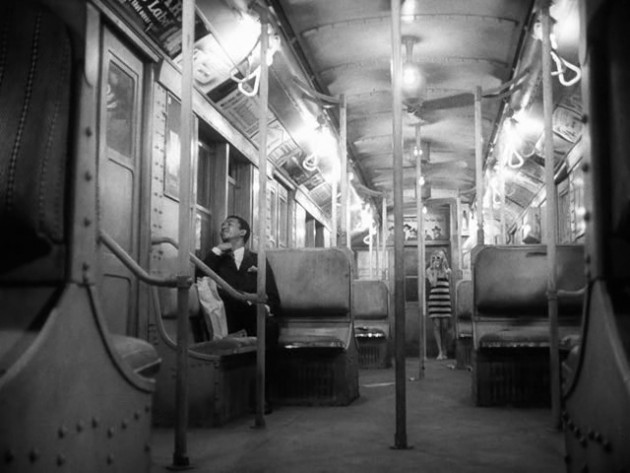
Lula with her apple
The woman, Lula (Shirley Knight), approaches the man, Clay (Al Freeman Jr.), eating her apple. Standing behind him she raises her sunglasses to her forehead, revealing her eyes, which are focused intently on the man. Her gaze is unwavering. The camera coalesces with the woman’s point-of-view looking down at the seated man who, looking up nervously at her, is diminished. Without words, and with very few movements, the actors have played out this odd exchange. Their exchange is not simply between a man and a woman, nor only between a black male and a white female, it is between a nice looking Sidney Poitier-type black male in a suit and tie who is reading a newspaper on a subway and a white female with blond hair and a dress who has been loitering on the platform. If this exchange were to take place on a street-corner at night with a male in a slow-moving vehicle peering out an open window at a female then it would most likely be read as a heavily coded sexual transaction; presented here it is jarringly out of place. Because of its seeming randomness the scene reflects a shocking ambiguity. The woman’s unrelenting gaze makes the exchange all the more disrupting. Whereas within classical Hollywood cinema the female would occupy the position of object to-be-looked-at and to be possessed instead, in Dutchman (Anthony Harvey, 1967) the male is refunctioned as the object of the gaze, and thus is feminized. The scene has become that of predator and prey in which the white female possesses phallic power and the black male is reduced to the feminized position of object within this sexual economy. At once the subject position of the black male is exposed as hierarchically below that of the white female. Where the female would traditionally hold a lower station, here, her race trumps her gender and places her above the male. Clay’s gendered race becomes the site where his masculinity is condensed opening up to questions about what it means to be a Black Man. This positioning is politically charged because, contextually, Amiri Baraka/Leroi Jones’ 1963 play Dutchman, and the subsequent film, came at the height of the civil rights movement, the women’s liberation movement, the sexual revolution, and at the beginning of the black power movement. Complex shifting of cultural values during the 1960s wedged a gap wherein the classed, raced, and gendered positions of white females and black males were suddenly negotiable, exposing the myth of equality—that for all ‘men’ to be equal conflates equality with the middle-class heterosexual white male perspective has been traditionally privileged. In Dutchman, ideologies of gender and race are destabilized through the Othered bodies of the two actors (black/white and male/female) as they negotiate for their subjectivities during a time of great social and political unrest.
Bodies are sites where discourses of power compete for, and constitute, gendered identities. Understanding femininity as “a mode of enacting and reenacting received gender norms which surface as so many styles of the flesh,” (Bartky, p. 131) female bodies are sites that reproduce feminine traits such as docility, poise, and grace through culturally valued economical gestures and pleasant appearance. The feminine takes up very little space; culture has prescribed that large, vulgar, displays of power or abundance (in size, gesture and volume) are relegated masculine traits. As feminist scholar Mary Russo has explained in her work on female grotesques and carnival theory there is always already danger present when there is a female who is actively making a spectacle of herself (Russo, p. 319). For Russo, a female making a spectacle of herself reveals the mask of femininity; transgressing and even signaling the loss of genders boundaries (Russo, p. 319). Confusing the gender dichotomy, Lula’s monstrous femininity is the appropriation of masculinity displayed by an unruly female body. In Dutchman, Lula’s femininity is monstrous. Lula is coded feminine simultaneous to her appropriation of masculine traits, in effect pressing up against the boundaries of both femininity and masculinity. Lula’s monstrous femininity is effectively expressed through actress Knight’s excessive open-mouthed moans and shrieks, and in her wiggly, slippery-snaky movements. Meanwhile, Clay’s precarious masculinity is displayed by Freeman’s restrained (seated) posture during the first two-thirds of the film. Lula displays femininity with a vengeance suggesting that her femininity is well within her control; her ability to perform her gender with such ease suggests the uncanny ability to take it off (Russo, p. 331). In order to represent gender as a stable, solid, concept all classifiable gendered expressions need to be well defined and static.
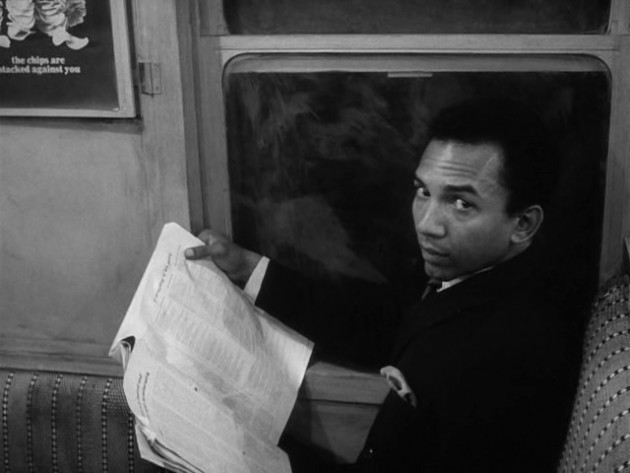
Clay framed in inferior position
Here, Knight’s performance in Dutchman heightens gender to the level of performance producing a distancing effect that suggests a mask exposing Other multiple intersections of oppression that coalesce with, condense, and collapse upon gendered identities. Ultimately, the recognition of gender as a mask is unsettling because it gives way to the instability of identity. At the beginning of the film, Clay is presented as fitting the problematic Poitier mold of black masculinity. Clay is emptied of any traces of dangerous sexuality because he performs a subdued, tamed, desexualized version of black masculinity. This type of black masculinity is, like Clay, feminized. Clay’s feminization is underscored by his objectification under Lula’s gaze. Clay is also feminized in his physical stature as seated, compared to Lula who moves around, commanding the space. Lula represents chaos, pushing the limits of containment and often exceeding the frame while Clay is static and stands-in for order. Lula assumes the dominant (masculine) position reconfiguring Clay as submissive Other (feminine). Through her unwavering stare and her constant prodding Lula diminishes Clay verbally, psychologically and, with her movements, physically. Lula’s performance of her gender does not correspond to any coherent definition or framework. Lula often acts more masculine than Clay. Throughout the film Lula is constantly in a state becoming therefore she is also constantly being abjected. She inhabits the space between good and evil, reason and insanity, man and woman, black and white, Adam and Eve. Referring back to Lula’s constant apple eating, Lula is not Eve within any working biblical symbolism; Lula is the snake in the garden and this never-ending subway ride is the fall. If Lula is neither Adam nor Eve then Clay’s position as a black man is jeopardized because the masculinity displayed by Clay does not present the danger within the scene. Lula presents the danger, wielding all the power within their exchange. Sublimated to Lula’s monstrous femininity Clay is powerless, desexualized, and impotent; Clay is castrated. Clay’s subjectivity is constituted through the abjection of Lula.
Clay’s restraint contrasts Lula’s excess through stillness of body and conservative economy of gesture. Clay displays cool composure while Lula performs hot agitation. The characters further contrast through their costumes—Clay clad in a suit and tie complete with a silk cravat in his breast pocket and Lula bare-legged in a loose mini-dress with wild, flowing, long-hair. Lula also commands “Black” language, using hip phrases and vernacular expressions that are not attributable to Clay’s blackness. Lula taunts Clay by wriggling and writhing her body around, loudly suggesting, “Let’s rub bellies! Rub bellies on the train. Do the nasty. Nasty!” Lula mocks Clay’s appearance saying she “knows his type” describing his, “funny boy jacket and all those buttons.” Lula emasculates and infantilizes Clay teasing him for, “trying to grow a beard and living with your parents in New Jersey.” Beyond its text, the contrast in the two actors’ use of voice, face, body, and speech is what opens up the film to myriad meanings. Lula’s constant motion (up and down, around Clay, near and far to his face and body) and her manipulation of dialogue through excessively varied speech patterns (volume, pitch, speed) demand and garner the desired explosive response from Clay. Freeman is then able to contrast his expression of black masculinity against both Clay’s feminized, whitened subjectivity, and against Lula.
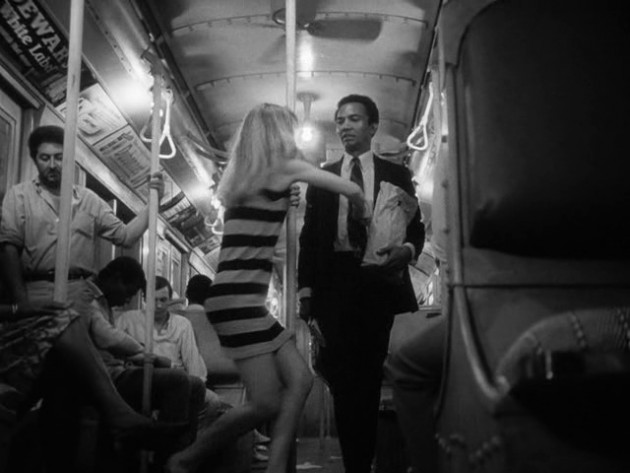
Lula stabs Clay
While the spectacle of the female transgressor represents the danger in Dutchman what is at stake is Clay’s manhood; his black masculinity. Lula not only speaks “blacker” than Clay, she lords both her volatile femininity and her violent masculinity over the symbolically castrated Clay. Lula’s appropriation of blackness and masculinity provokes Clay to step into his own blacker masculinity. What makes Lula dangerous is manifest through Knight’s embodied expression of Baraka/Jones’s incendiary dialogue. While Baraka/Jones’ condemnation of Clay’s non-masculine/non-black masculinity is incendiary, it is Knight’s performance that ignites the fuse setting off Clay’s explosive expression of black masculinity. Lula’s is indeed provocative, publicly condemning Clay a “middle-class black bastard” spitting contemptuously, “why you ain’t no nigger, you’re just a dirty white man!” Problematizing viewer identification by exposing identity as enmeshed in a matrix of race, gender, sexuality, and class, Clay’s racially constituted gender is the subject of scrutiny, critique and exploration. Dutchman is then about becoming a Black Man in America—and what that means.
Dutchman’s dialogue is politically charged yet Knight’s performance is what enables the film to be as chilling and shocking as it is. Knight’s Lula is wild; she actively uses her face, her voice and her body to take Baraka/Jones’ dialogue to another level. Knight’s stare, like Medusa’s, can freeze a man. Knight makes Lula a laughing Medusa who cackles hysterically, flaunting and taunting with her to-be-looked-at-ness, returning a deadly gaze. Knight’s precise characterization doubles the scripts volatility, consistently upping the ante. When Freeman’s Clay stands up (figuratively, for himself, and literally, as he has been seated for most of the preceding forty minutes) Knight’s Lula changes instantly from actively making a violent and vicious spectacle of herself to silent, still, and small. Suddenly Lula’s femininity is contained, as she appears frightened and fragile. Her eyes are now wide, where they had been focused half-mast and cast down her nose judgmentally. Her mouth is shut tight, where it had been gaping, and grimacing. Lula is now silent when moments before she had been singing, laughing, chanting, swearing, screaming, shrieking and moaning; she has been effectively shut up. The virile and violent black masculinity she had been mimicking and mocking Clay with, manipulating and prodding him, is actualized. Clay’s rage is as justified as it is self-righteous, yet what makes his outburst effective is in Knight’s embodiment of the abruptly feminized, diminished, silenced and amply shocked Lula. Clay’s emotional outburst is inversely mirrored by Lula’s physical response. The bigger Clay becomes (in volume, speech, and movement) the smaller Lula becomes whereas the bigger Lula becomes Clay is by contrast smaller.
Lula provokes Clay’s expression of black masculinity by disrupting his understanding of what it means to be a black man, by actively questioning Clay’s self-worth. Clay is then dually denied his identity as black and as a man; race is not only problematized, but becomes the site where gender and sexuality are in the messy process of negotiation. If the height of Lula’s danger is in her monstrous femininity, Clay’s danger is doubly present in the potential monstrosity of both his race and his gender –his blackness and his manhood– as Clay’s gender and race becomes the platform for his rage and his rage symbolically becomes Black Anger (a scary notion, indeed). Activating the otherwise docile body is to revolt against the existing power structures rendering such violent pronouncements of identity politics dangerous. By announcing himself as a Black Man, Clay in effect erases himself as Clay. Whereby Lula has reminded Clay again and again that, as a black man, he is only ‘loved’ (read: tolerated in society) for not killing what he hates, when he very well could, his revolt is doomed to be met by the same fate as it always has historically: murder (as in the play). The revolutionary potential of black masculinity threatens the dominant paradigm of patriarchy. Played out as it does in Dutchman, the underlying danger is dually that of miscegenation—whereby racial boundaries are effectively obliterated. If the masculine is conflated with power then the black masculine presents a double threat to the dominant paradigm.
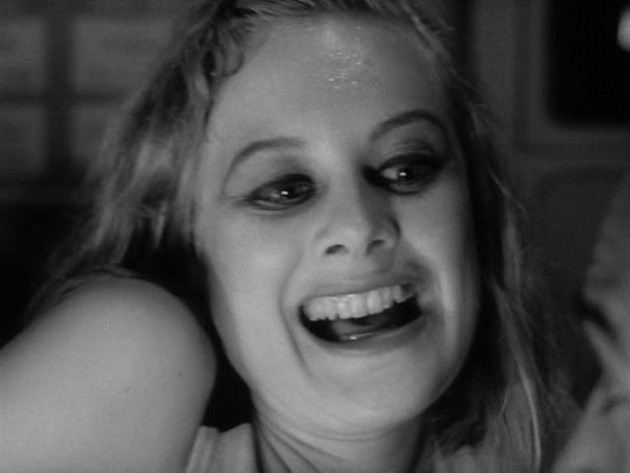
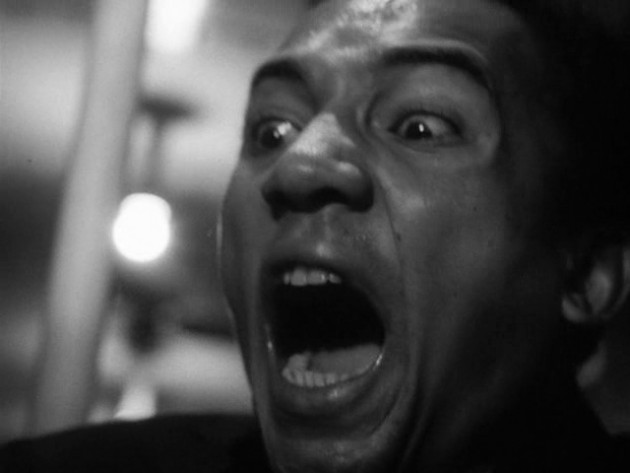
Primal Screams
Clay’s becoming black masculinity is a public act of negotiation for, and process of, self-identification that is ultimately suicidal. Clay is coerced into engaging with his own black masculinity for which he is punished. Clay’s rage is justified and righteous but such a powerful force can only be met with one plausible conclusion: death. Death is the ultimate form of silence, containment, and control. Knight’s performs Lula with such violent instability that she is able to alienate the viewer, making the shocking conclusion all the more effective when Clay lashes out violently and then is killed. The danger of black anger (and black masculinity) is symbolically silenced when Lula murders Clay. The film poses the problem of viewer identification from the start by presenting these two Others; however it is Knight’s monstrous performance that pushes the viewer to identify with Freeman’s Clay because her Lula is so volatile. Knight performs Lula as a character whose purpose is to repel through grotesque displays of being, not rooted in psychology. Knight ignites Baraka/Jones’ dialogue opening up the film to questions about power, identity, masculinity, gender, sexuality, class and race. Dutchman signals an always-already present and impending tragedy for the dangerous combination of blackness and masculinity. Dangerous fusions such as these highlight the complexity of identification in so far as identity is not a category but a politically charged process of becoming that carries with it revolutionary potential.
Works Cited
Bartky, Sandra Lee. “Foucault, Femininity and the Modernization of Patriarchal Power” in Writing on the body: female embodiment and feminist theory. Katie Conboy, Nadia Medina, and Sarah Stanbury, eds. New York: Columbia University Press, 1997: 129-154.
Russo, Mary. “Female Grotesques and Carnival Theory” in Writing on the body: female embodiment and feminist theory. Katie Conboy, Nadia Medina, and Sarah Stanbury, eds. New York: Columbia University Press, 1997: 318-336.


